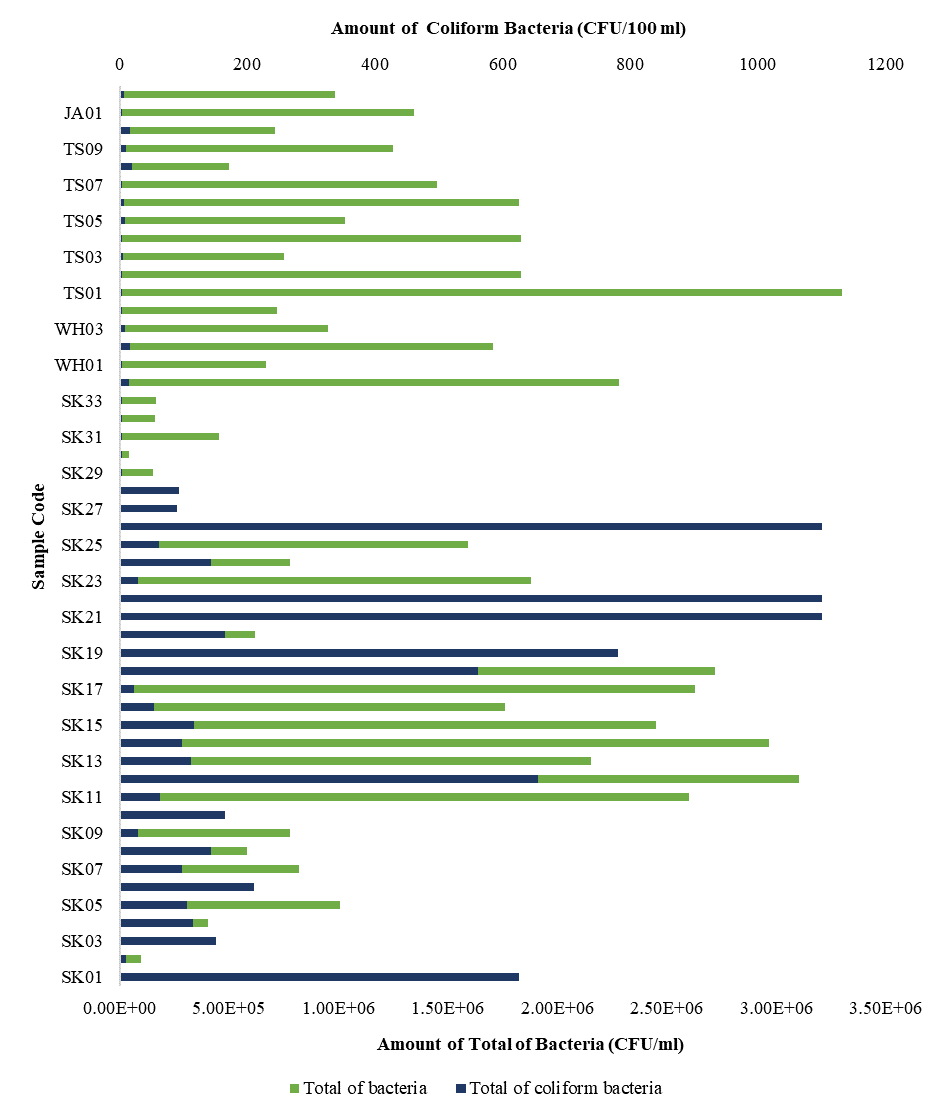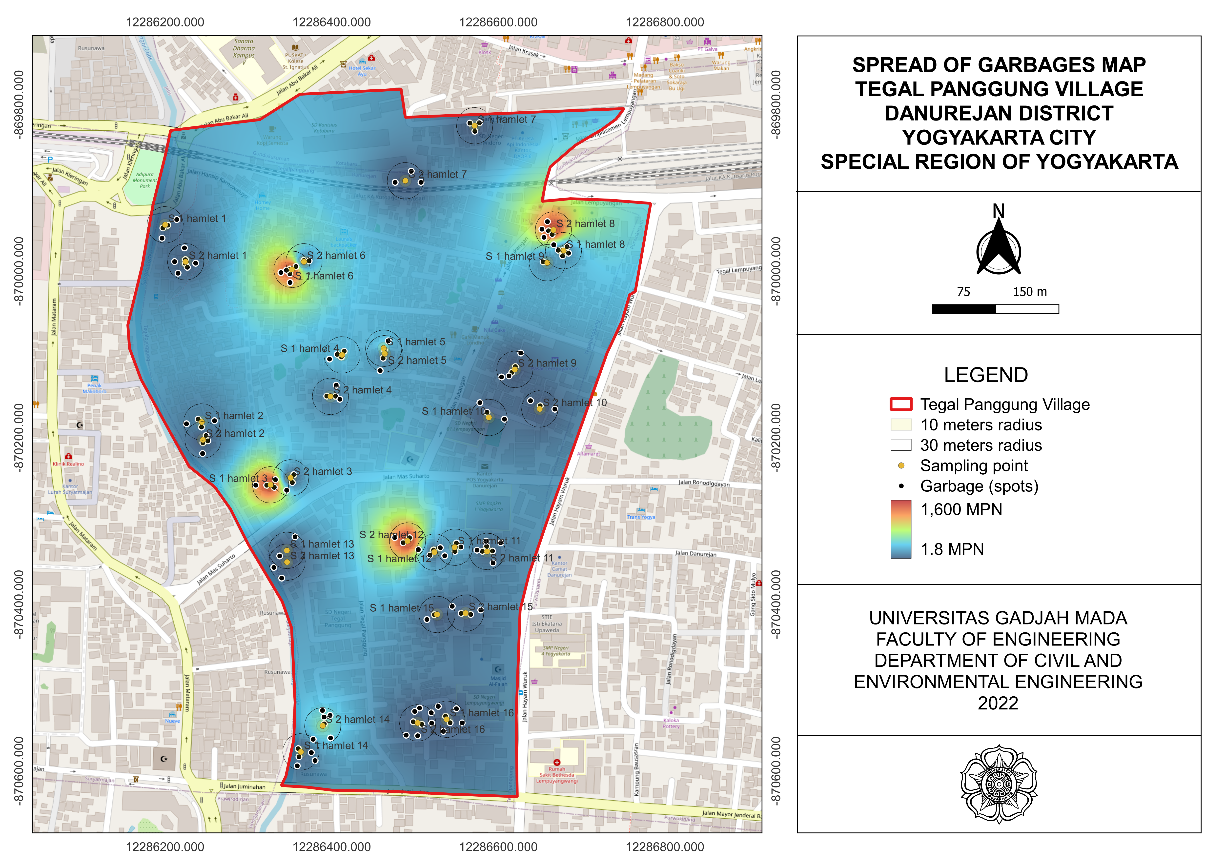Processing System and Evaluation Microbiological Quality of Drinking Water Fountain in Surabaya City
Downloads
District Central Statistic Agency of East Java. Provinsi Jawa Timur dalam Angka. Surabaya: District Central Statistic Agency of East Java; 2020. https://jatim.bps.go.id/
Ministry of Health Republic of Indonesia. Regulation of Ministry of Health Republic Indonesia No. 492/MENKES/2010 about Quality Requirements of Drinking Water. Jakarta: Ministry of Health Republic of Indonesia; 2010
World Health Organization. Diarrhoeal Disease. Geneva: World Health Organization; 2017 https://www.who.int/news-room/fact-sheets/detail/diarrhoeal-disease
Ayuningrum FV, Salamah M. Analisis Faktor Sanitasi dan Sumber Air Minum yang Mempengaruhi Insiden Diare pada Balita di Jawa Timur dengan Regresi Logistik Biner. J Sains Seni ITS. 2015;4(2):223–228. http://ejurnal.its.ac.id/index.php/sains_seni/article/view/10799
Juuti PS, Antoniou GP, Dragoni W, El-gohary F, Feo G De, Katko TS. Short Global History of Fountains. Water. 2015;7(5):2314–2348. https://dx.doi.org/10.3390/w7052314
Ihsan A, Iqbal MM, Siswanto dan A. Kajian Kebutuhan dan Distribusi Pembangunan Keran Air Siap Minum (KASM) di Kawasan Jakabaring Sport City. Pros Simposium II – UNIID 2017. 2018;2(1):978–979. http://conference.unsri.ac.id/index.php/uniid/article/view/593/206
Arfiansyah R, Prabawati I. Implementasi Corporate Social Responsibility (PDAM) Surya Sembada Kota Surabaya (Studi Pada Kran Air Siap Minum (KASM) di Taman Bungkul Surabaya). J Publika. 2016;4(5):1–7. https://jurnalmahasiswa.unesa.ac.id/index.php/publika/article/view/14983/
Bintoro G. Pemeliharaan Fasilitas Water Tap (Studi Kasus pada ITB dan UNS). JPSI. 2018;2(2):56–60. https://doi.org/10.26740/jpsi.v2n2.p56-60
Inassa I. Persepsi Masyarakat Kota Surabaya Tentang Program Kran Air Siap Minum (KASM) PDAM Surya Sembada Kota Surabaya. Skripsi. Surabaya: Universitas Airlangga; 2019.
Alam AS, Matalata H. Perancangan Alat Pengolahan Air Minum
Otomatis pada Proses Netralisasi pH dan Aerasi. J Electrical Power Control and Automation. 2018;1(2):33–38. http://dx.doi.org/10.33087/jepca.v1i2.8
Silalahi J. Dampak Negatif Air Minum Reverse Osmosis (RO) terhadap Kesehatan. J Indonesia Medical Association Majalah Kedokteran Indonesia. 2014;64(5):215–217. http://mki.idionline.org/index.php/index.php?uPage=mki.mki_dl&smod=mki&sp=public&key=Mzc5LTE3
Tominik VI, Haiti M, Hutabarat MS. Analisis Uji Kualitas Bakteriologis Air Minum Isi Ulang (AMIU) Menggunakan Metode MPN pada Pengolahan Air Sistem Reverse Osmosis (RO) dan Sistem Ultra Violet (UV). J Kesehatan Saelmakers Perdana. 2018;1(1):20–24. http://ojs.ukmc.ac.id/index.php/JOH
Rohman A, Negara MAP, Supeno B. Sistem Pengaturan Laju Aliran Air pada Plant Water Treatment Skala Rumah Tangga dengan Kontrol Fuzzy-Pid. J Berkala Sainstek. 2017;5(1):29–34. https://doi.org/10.19184/bst.v5i1.5371
Robbani MH, Setiadi I. Optimalisasi Kinerja Perangkat Peningkat pH Berbasis Resin Magnesium Oksida Untuk Produksi Air Siap Minum. J Rekayasa Lingkungan. 2019;12(2):107–117. http://ejurnal.bppt.go.id/index.php/JRL/article/view/4019/3326
PDAM Surya Sembada of Surabaya City. Report of Drinking Water Fountain (KASM) 2019-2020. Surabaya: PDAM Surya Sembada of Surabaya City; 2020
Ministry of Public Works and Housing Republic of Indonesia. Regulation of Ministry of Public Works and Housing Republic of Indonesia No.26/PRT/M/2014 about Standard Operational Procedure of Water Supply System Management. Jakarta: Ministry of Public Works and Housing Republic of Indonesia; 2014.
Mairizki F. Analisis Kualitas Air Minum Isi Ulang Di Sekitar Kampus Universitas Islam Riau. J Katalisator. 2017;2(3):9–19. https://doi.org/10.22216/jk.v2i1.1585
Freitas DG, Dyego R, Silva R, Artur L, Bataus M, Barbosa MS. Bacteriological Water Quality In School ' S Drinking Fountains And Detection Antibiotic Resistance Genes. Annals of Clinical Microbiology Antimicrobial. 2017;16(1):645–648. http://dx.doi.org/10.1186/s12941-016-0176-7
Zikra W, Amir A, Putra AE. Identifikasi Bakteri Escherichia coli pada Air Minum di Rumah Makan dan Cafe di Kelurahan Jati serta Jati Baru Kota Padang. J Kesehat Andalas. 2018;7(2):212–216. http://dx.doi.org/10.25077/jka.v7.i2.p212-216.2018
Ratri LP, Wulandari W. Keberadaan Coliform pada Depo Air Minum Isi Ulang di Gambirsari Surakarta. Proceeding of The URECOL. 2018;(492):66-71. http://repository.urecol.org/index.php/proceeding/article/view/300
Utami ES, Saraswati LD, Purwantisari S. Hubungan Kualitas Mikrobiologi Air Baku dan Higiene Sanitasi Dengan Cemaran Mikroba Pada Air Minum Isi Ulang di Kecamatan Tembalang. J Kesehatan Masyarakat. 2017;5(4):236–244. https://ejournal3.undip.ac.id/index.php/jkm/article/view/19874/18790
Sunardi, Ruhyanuddin F. Perilaku Mencuci Tangan Berdampak Pada Insiden Diare pada Anak Usia Sekolah di Kabupaten Malang. J Keperawatan. 2017;8(1):85–95. http://ejournal.umm.ac.id/index.php/keperawatan/article/view/4021
Wulansari NT, Parut AA. Pengendalian Jumlah Angka Mikroorganisme Pada Tangan Melalui Proses Hand Hygiene. J Media Sains. 2019;3(1):7–13. https://www.jurnal.undhirabali.ac.id/index.php/jms/article/view/694/616
Cordita RN, Soleha TU, Mayasari D. Perbandingan Efektivitas Mencuci Tangan Menggunakan Hand Sanitizer dengan Sabun Antiseptik pada Tenaga Kesehatan di Ruang ICU RSUD Dr. H.Abdul Moeloek. J Kesehatan dan Agromedicine. 2019;6(1):145–153. https://juke.kedokteran.unila.ac.id/index.php/agro/article/view/2266/
Pakpahan RS, Picauly I, Mahayasa INW. Cemaran Mikroba Escherichia coli dan Total Bakteri Koliform pada Air Minum Isi Ulang. Kesmas Natlonal Public Health J. 2015;9(4):300–307. http://dx.doi.org/10.21109/kesmas.v9i4.733
Sumampouw OJ. Kandungan Bakteri Penyebab Diare (Coliform) Pada Air Minum (Studi Kasus Pada Air Minum dari Depot Air Minum Isi Ulang di Kabupaten Minahasa). J Public Health Without Border. 2019;1(2):8–13. https://ejournalhealth.com/index.php/phwb/issue/archive
Nurkhikmah S, Budiono Z. Kualitas Mikrobiologis Air Minum Isi Ulang pada Depot Air Minum Isi Ulang di Wilayah Kerja Puskesmas Kebasen Kabupaten Banyumas Tahun 2017. Buletin Keslingmas. 2017;37(4):456–68. http://dx.doi.org/10.31983/keslingmas.v37i4.3797
Nurpauji SV, Nurjazuli, Yusniar. Hubungan Jenis Sumber Air , Kualitas Bakteriologis Air , Personal Hygiene Dengan Kejadian Diare Pada Balita Di Wilayah Kerja Puskesmas Lamper Tengah Semarang. J Kesehatan Masyarakat. 2015;3(1):569–578. https://ejournal3.undip.ac.id/index.php/jkm/article/view/11542
Dewanti RA, Sulistyorini L. Analisis Kualitas Bakteriologis Air Minum Isi Ulang di Kelurahan Sememi, Kecamatan Benowo. Indonesian J of Public Health. 2017;12(1):39–50. http://dx.doi.org/10.20473/ijph.v12i1.2017.39-50
Vidyabsari, Hamdan YL. Hubungan Higiene Sanitasi Pengolahan Air Minum Isi Ulang dengan Penyakit Diare Pada Balita. J Ilmiah Permas STIKES Kendal. 2018;8(1):29–36. http://journal.stikeskendal.ac.id/index.php/PSKM/article/view/192/128
Phurisamban R, Gleick P. Drinking Fountains and Public Health Improving National Water Infrastructure to Rebuild Trust and Ensure Access. Oakland. CA: Pacific Institute. 2017:1-8.
2. Formal legal provisions to access digital articles of electronic journal are subject to the provision of the Creative Commons Attribution-ShareAlike license (CC BY-NC-SA), which means that Jurnal Kesehatan Lingkungan is rightful to keep, transfer media/format, manage in the form of databases, maintain, and publish articles.
3. Published manuscripts both printed and electronic are open access for educational, research, and library purposes. Additionally, the editorial board is not responsible for any violations of copyright law.
JKESLING by UNAIR is licensed under a Creative Commons Attribution-ShareAlike 4.0 International License.







































